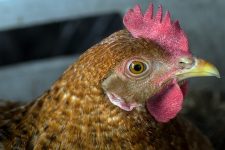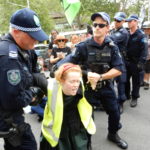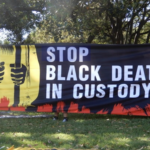Should the Inhumane Slaughter of Animals Be Outlawed?

Each year, 50,000 chickens are slaughtered on New York streets during Yom Kippur, as part of the Jewish ritual of Kaporos. The process involves:
“the practitioners’ grasping of live chickens by their wings and swinging them above their heads three times and reciting prayers. The purpose of this act is to transfer the practitioner’s sins to the birds. After swinging the bird, the adherents slit the chickens’ throats with a sharp knife. The meat is then donated to the poor.”
The ritual is believed to transfer human sin to the chicken.
A legal challenge against the practice was brought by Brooklyn-based animal rights group “The Alliance to End Chickens as Kaporos” and twenty other plaintiffs, but was ultimately struck down by the Supreme Court on the basis that it did not amount to a “public nuisance”.
Although the Court’s decision had little to do with religious freedom, Orthodox Jews have claimed it as an important win for their religious rights.
But a representative of the plaintiffs expressed outrage at the decision, stating:
“This is an egregious event with respect to public-health issues, quality-of-life issues, and animal-cruelty issues. To be forced to endure opening up your front door annually to a mass animal slaughter is just dumbfounding.”
Other Inhumane Practices
Orthodox Jews are certainly not the only group to engage in methods of slaughter that can inflict protracted suffering on animals.
Both Kosher slaughter, or ‘shechita’ (for practising Jews), and Halal slaughter (for practising Muslims) are supposed to be conducted in such a way as to minimise the animal’s pain.
In the case of Kosher slaughter, which is undertaken according to Jewish law (‘Halacha’), a person known as a ‘Shoschet’ delivers a deep slit to the animal’s throat which is intended to render it unconscious. The animal then bleeds to death.
Similarly, Halal slaughter involves a deep slash to the animal’s throat which is supposed to cause unconsciousness and bleeding to death.
In Australia, it is generally required that animals be given a ‘reversible stun’ before their throats are slit, which is meant to put them into a “state of deep unconsciousness” so that they do not awaken while dying.
However, exemptions have been granted in Australia which allow religious killing without prior stunning for both Halal and Kosher slaughter – which can cause great distress and protracted suffering to animals. And many overseas countries do not have the requirement of pre-stunning at all.
Aside from religious killings, organisations like PETA and The Humane Society have uncovered cruel slaughter practices in abattoirs throughout the world.
Animal Cruelty in NSW
According to Australian Rabbis, the ritual killing of animals is quite different and more humane here than in the United States.
Yet recent years have seen calls for all inhumane slaughtering practices to be outlawed in Australia, regardless of religious requirements.
Section 5 of the Prevention of Cruelty to Animals Act 1979 (NSW) (‘the Act’) makes it an offence to commit ‘an act of cruelty’ upon an animal.
Section 4 defines ‘cruelty’ as including any beating, kicking, wounding of an animal, exposure to excessive heat or cold or inflicting pain on an animal. Cruelty also includes failing to take reasonable care of an animal, or to take reasonable steps to alleviate pain or suffering, or to provide necessary veterinary treatment.
It is also an offence to authorise another person to commit an act of cruelty on an animal that you own, or are in charge of.
The maximum penalty for animal cruelty is 6 months imprisonment and/or a fine of $5,500 for an individual, or a $27,500 fine for a corporation.
Section 6 of the Act relates to ‘aggravated cruelty’, which is defined by section 4 as:
(a) causing the death, deformity or serious disablement of the animal, or
(b) the animal being so severely injured, so diseased or in such a physical condition that it is cruel to keep it alive.
The maximum penalty for aggravated animal cruelty is 2 years imprisonment and/or a fine of up to $22, 000 for individuals, or a fine of $110, 000 for corporations.
Section 530 of the Crimes Act 1900 (NSW) contains an additional offence of “serious animal cruelty” which includes torturing, beating or killing an animal. That offence comes with a maximum prison term of 5 years.
Defences to Animal Cruelty
A whole range of defences to animal cruelty are contained in section 24 of the Act, including religious slaughter; see section 24(c)(i) below.
The section says that a person is not guilty of animal cruelty where the act was committed upon:
(a) (i) a stock animal–in the course of, and for the purpose of, ear-marking or ear-tagging the animal or branding, other than firing or hot iron branding of the face of, the animal,
(ii) a pig of less than 2 months of age or a stock animal of less than 6 months of age which belongs to a class of animals comprising cattle, sheep or goats–in the course of, and for the purpose of, castrating the animal,
(iii) a goat of less than 1 month of age or a stock animal of less than 12 months of age which belongs to the class of animal comprising cattle–in the course of, and for the purpose of, dehorning the animal,
(iv) a sheep of less than 6 months of age–in the course of, and for the purpose of, tailing the animal, or
(v) a sheep of less than 12 months of age–in the course of, and for the purpose of, performing the Mules operation upon the animal,in a manner that inflicted no unnecessary pain upon the animal,
(b) where the act of cruelty is done in the course of, and for the purpose of:
(i) hunting, shooting, snaring, trapping, catching or capturing the animal, or
(ii) destroying the animal, or preparing the animal for destruction, for the purpose of producing food for human consumption,
in a manner that inflicted no unnecessary pain upon the animal,
(c) in the course of, and for the purpose of, destroying the animal, or preparing the animal for destruction:
(i) in accordance with the precepts of the Jewish religion or of any other religion prescribed for the purposes of this subparagraph, or
(ii) in compliance with any duty imposed upon that person by or under this or any other Act,
(e) in the course of, and for the purpose of:
(i) carrying out animal research, or
(ii) supplying animals for use in connection with animal research,
in accordance with the provisions of the Animal Research Act 1985, or
(f) for the purpose of feeding a predatory animal lawfully kept by the person if:
(i) the act concerned was the release of live prey for the predatory animal, and
(ii) the diet of the predatory animal included animals of the kind released, and
(iii) the person believed on reasonable grounds that the feeding of live prey to the predatory animal was necessary for the predatory animal’s survival because the predatory animal would not eat a dead animal or meat from a dead animal.
Despite the breadth of these defences, it is hoped that humans will show compassion to the vulnerable animals that are entrusted to them.






